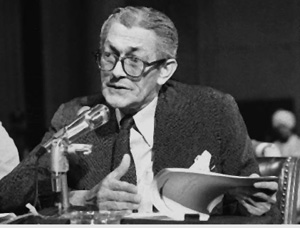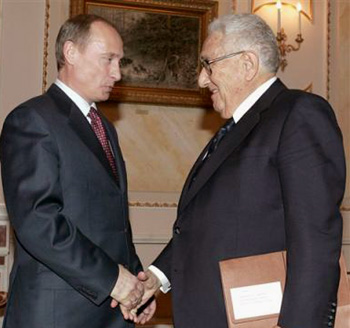 |
International Affairs
... An Alternative View of U.S. Espionage
Distorted Images in a Forest of Mirrors
Toby Westerman
Recent films misrepresent it, the media carry stories of its incompetence, but without it the United States cannot long survive. Without dependable information from intelligence sources, our nation operates blindly in a dangerous world. International News Analysis spoke with an intelligence expert, Charles Viar, head of the D.C.-based Center for Intelligence Studies, who provides a challenging view of America's intelligence capability.

James Angelton, founder of US counterintelligence |
Viar learned about the world of intelligence from James Jesus Angleton, the legendary - or infamous, depending upon the source, founder of U.S. counterintelligence. Angleton joined the CIA at its inception in 1947, and established the counterintelligence unit in 1954. In December 1974, Angleton was forced out of his position, purportedly because of a prolonged and damaging hunt for a non-existent mole. At the time of his retirement, however, Angleton received the Distinguished Intelligence Medal, the CIA's highest decoration.
A recent film, The Good Shepherd, is based on an Angleton-like figure, suspicious of all, but in the end, trusting the individuals who betray him. In view of past intelligence humiliations, the survival of the nation may depend on a reconsideration of Angleton's strategies, Viar indicated to INA.
"He was a very cautious, decent man," Viar said of Angleton. Despite his caution and rectitude, Angleton did not hesitate to "point out the fallacies of thinking" of fellow intelligence officers and career diplomats..
Angleton believed that counterintelligence is a vital tool in the struggle to protect the United States against those determined to destroy the nation. Angleton realized that it is possible to mislead a nation - including the United States - to the point where the nation's leaders are manipulated into making decisions destructive to the national survival. He did not believe that it is possible to accurately assess the actions or intensions of closed societies hostile to the U.S.
Angleton's counterintelligence theories have direct application now, when the motivations of "democratic" Russia and Communist China appear contradictory and enigmatic. While the actions of Moscow and Beijing toward the U.S. appear uncertain, Russian and Chinese intelligence services are mounting concerted efforts against U.S. civilian and military targets of interest.
The profound mistrust of Angleton regarding the ability of the U.S. or any other nation to judge the truth of statements issued by leaders of closed societies, especially America's arch-rival, the Soviet Union, put him on a collision course with the most important diplomat of his day, Henry Kissinger. Negotiations concerning the arms limitation treaty Salt I depended upon America's ability to verify the compliance of the Soviet Union with provisions of the treaty. Kissinger wanted acceptance of the treaty in Washington, and Angleton's profound skepticism of any possibility of accurate verification of Soviet compliance meant that the two men stood at odds on a very vital point for American security, Viar told INA.

Kissinger continues to promote relations with Russia. Above, with Putin in Moscow in Feburary 2005 |
The appointment of William Colby as CIA Director resulted in the firing of Angleton and those who shared his views. The counterintelligence section of the CIA fell from 300 officers before Angleton's termination to an estimated 80 afterward.
Angleton's mistrust of the obvious could be used to explain the continuity of espionage activities of FBI's chief counterintelligence officer and traitor, Robert Hanssen. Over the 22 years of intermittent spying, he worked for both the Soviet Union and "democratic" Russia. During one of Hanssen's dormant periods, between 1991 and 1999, the Soviet Union collapsed and Boris Yeltsin, president of the new Russian Federation, promised that communism would never return to his country.
Despite the revolutionary changes in governments in Moscow and presumably in the political power structure of the Russian nation, Hanssen was able to easily restart his relationship with his espionage "friends." There was no indication of interruption of personnel or of motivation on the Russian side.
Viar speculates that the Kremlin leadership recognized in the early 1980s that communism could not exist without some form of capitalism. The KGB helped carry out a "controlled transition" to a quasi-capitalist society. Viar dismisses the current division of the old KGB into the FSB (internal intelligence) and the FSV (foreign intelligence) as merely cosmetic. He refers to Russian intelligence services as simply the "KGB."
Viar is not alone in his use of the term KGB. In November 2004, Elena Bonner, wife of the late Soviet dissident Andrei Sakharov, declared that "Russia is ruled by the KGB." Other intelligence authorities have referred to Russia as a "Chekist" state, a nation governed by intelligence officers who trace their professional lives back to the Cheka, the original name for the Bolshevik secret police. The Cheka was founded in 1917, and, therefore, is older than the Soviet Union, which was not founded until 1922.
Viar and his associates are currently researching the phenomenon of global integration and the financial elite believed to promote it, and are inquiring into the possible use of drugs and mind control techniques to ensure that suicide bombers do not turn back from their missions of death.

Posted February 12, 2007
Toby Westerman writes and edits
International News Analysis - Today
An investigative, analytical, and uncompromising weekly analysis of the world situation
Contact T. Westerman at www.inatoday.com
or P.O. BOX 5182, Rockford, ILL, 61125-0182
|
International Affairs | Hot Topics | Home | Books | CDs | Search | Contact Us | Donate

© 2002- Tradition in Action, Inc. All Rights
Reserved
|
 |
|